by Megan Tady
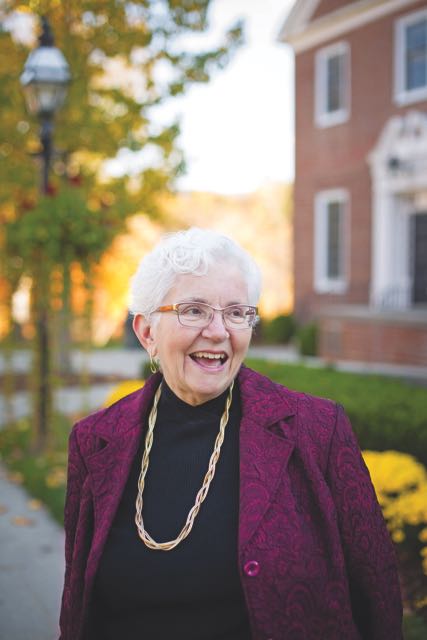 On the lawn next to Hathaway House in 1973, shovel-wielding eighth graders dug into the dirt. The hole grew bigger, and impressively deep. From it, they pulled buried china doll heads, twisted pieces of metal, and hairbrushes.
On the lawn next to Hathaway House in 1973, shovel-wielding eighth graders dug into the dirt. The hole grew bigger, and impressively deep. From it, they pulled buried china doll heads, twisted pieces of metal, and hairbrushes.
They were exhuming a 20th century household dump. History teacher Karin O’Neil and colleague Thomas Smith were leading a bona fide archeological dig. What better way to teach history than to let kids unearth it?
Ms. O’Neil, Mr. Smith, and their students had organized an efficient setup. Some kids dug while others used sifters to gently shake away the soil from the artifacts. The dig itself lasted for several weeks, revealing other treasures—a salt-blazed stoneware crock, soles of shoes, pieces of Imari ceramic pottery that they glued back together—all clues to a different way of life, of people who lived on the same land before them. Researching the artifacts took longer, but ultimately the students proudly presented their findings to the Easthampton Historical Society.
“We were always looking for innovative ways to help students understand the way ‘history’ is made,” Ms. O’Neil says.
Paul Sigris ’78, was among those eighth grade excavators. He says his memories of the dig are “vivid.”
“It was a hands-on approach to teaching American history,” he says. “We weren’t watching an archeological dig, we were doing an archeological dig. There was a huge difference. It also meant that we got dirty.”
During her 33-year tenure at Williston Northampton, as both a teacher and an administrator, Ms. O’Neil had a talent for uncovering something miraculous just below the surface—from an old hairbrush, to a teacher’s innate ability to inspire a classroom of students. She took everything to the next level: first elevating how she taught history and then elevating how the school, collectively, approached the curriculum.
As the director of the Middle School, the academic dean, the dean of faculty, the assistant head, and finally, as associate head of school from 1990 to 2001, Ms. O’Neil was an historian who was also quietly, and rather cheerily, making history.
“To this day, I have an interest in archeology,” says Mr. Sigrist, an actor, who for 10 years directed an oral history project at the Ellis Island Immigration Museum. “Doing that dig was kind of a dream come true. Going down into that dirt seven feet down and pulling stuff out of the dirt, it was heaven. Certainly Ms. O’Neil fostered and cultivated that life-long interest in history, and I eventually pursued it as a career.”
GROOVING ON CHALLENGES
When Ms. O’Neil signed on to teach at the Northampton School for Girls (NSFG) in 1967, she only expected to stay for one year. She had just earned her master’s degree in history, and she “bumbled” her way into teaching, believing the year would give her time to figure our her career path. Then she had what she calls the “light bulb experience.” It changed everything.
“There’s that moment of inner feeling when a students grasps something, and you can see that you had something to do with that,” she says. “Once that happened, I was hooked.”
That, and NSFG was on the brink of merging with Williston Academy. Ms. O’Neil wanted to support her students through the monumental change.
“[Williston Academy] had a strong male culture,” she says. “I felt really strongly that the girls would need some female advocates.”
Assistant Head of School Ann Pickrell says Ms. O’Neil was instrumental in successfully melding the two schools.
“She brought many of the NSFG traditions to Williston,” Ms. Pickrell says. “She was very mindful of that from a perspective of an historian; she was not willing to let that aspect of [NSFG] disappear.”
During the first year or two of the merger, Ms. O’Neil did find herself advocating for the female students along with some of her NSFG and Williston colleagues.
“There was a dark cloud of feeling that the women brought lower academic standards than the men,” Ms. O’Neil says. “Some of those women went on to just do phenomenal things. So vindication is sweet, because they were real leaders in their fields.”
It was an exciting time for Ms. O’Neil, who describes herself as a “raw rookie” who “grooved on challenges.” It was the early 70s, and her dog nipped at her students’ bellbottomed jeans as they strolled across campus.
“It was a time of chaos,” she says. “And it was a time of huge change in American culture. People were trying to get a clear footing on what education should be, how traditional the school should be, discipline, what kind of innovation should there be. Everybody was groping for the way that would make things work better.”
On occasion, Ms. O’Neil herself was on the front lines of disciplining her students. When a male student perpetually skipped her class, she decided to track him down in his dorm—at a time when women and men didn’t typically set foot in each other’s living quarters.
“The boys [in my class] looked at me and said, ‘You wouldn’t.’ I said, ‘Just watch me.’”
Leaving her class with a student teacher, Ms. O’Neil marched over to the missing student’s dorm room and rapped on the door.
“There he was, standing in his boxers,” she says. “And I said, ‘You will get dressed. You will be in my class before it is over. And you are not to be late again. And he wasn’t late—for about two months.”
At the newly minted Williston Northampton, Ms. O’Neil found a school that encouraged her to think creatively.
“I’m a doer,” she says. “If I saw something that was needed, I would speak up. I learned how to speak up pretty quickly in that first year ofthe merger, otherwise I would have been blown out of the water.”
Instead, she swam with the current, and eventually started carving her own tributaries.
“Somebody says, “Ok, you have an idea, go do it.’ That’s really how I got into administration,” she says.
PROVIDING THE GLUE
Before the late 1970s, Williston Northampton, like most independent schools, didn’t have a formal and well-articulated system to evaluate teachers. Rather, the culture of independent schools supported teachers’ independence in a classroom and in developing curriculum.
“At independent schools, historically, teachers could go into their classrooms that were like little egg cartons and nobody could check on them,” Ms. O’Neil says. “[Teachers] could do whatever they wanted. It was their own private fiefdom.”
She continued, “The general tone, and this isn’t critical of Williston, was: ‘All I have to do is stand outside the door for 15 minutes and I tell if someone is a good teacher or not.’ And I said, ‘I don’t think it’s that easy.’”
In her role as academic dean from 1977-1985, Ms. O’Neil says she gained a broader perspective on new research that delved into the science and theory of teaching and learning.
“There was a huge explosion of knowledge about how people learn and how brains work,” she says. “I wanted to find out what really works in teaching.”
She attended conferences and trainings, and slowly began to shift how Williston Northampton approached teaching. With key help from some of her colleagues, she introduced classroom observations, a teacher evaluation structure, and a new teacher orientation program. She also pushed for summer study opportunities for faculty.
“She was one of the first people to talk about curriculum mapping and to get us to do it,” Ms. Pickrell says. “She wanted people who were good teachers to be better teachers.”
Dean of Faculty Peter Valine says Ms. O’Neil was pivotal to establishing Williston Northampton’s culture of professionalism.
“She was able to bring a level of respect and admiration that served the interest of the school community so well,” he says. “She was upholding professional institutional values, and doing it in a way that you felt like you had her complete support.”
The task wasn’t easy. It was like righting a large ship, asking it to go in another direction.
“It was a long, hard road,” Ms. O’Neil says. “But a lot of people came through. I couldn’t have done it without the whole faculty. I think I provided the glue. The people were working together in a way they hadn’t in the past.”
For years, on her office door, she hung a quote from the Chinese philosopher Lao Tzu: “A leader is most effective when people barely know he exists. When his work is done, his aim fulfilled, his troops will feel they did it themselves.”
She lived and led by this motto.
A LIFE REFLECTED
On a sunny, surprisingly warm day this fall, Ms. O’Neil sat on a bench outside the Homestead, giving jolly hellos to the many people who recognized her. Back for a visit from her home in Ohio, she surveyed the campus. Had it changed? Oh yes.
Ms. O’Neil left Williston Northampton in 2001, moving to Ohio to become the executive director of the Ohio Association of Independent Schools. She retired in 2011, but is still on the board for the League of Women Voters and is writing a family history for her two grandchildren.
After studying the art, science, and theory of teaching for years, Ms. O’Neil has a few thoughts about what makes a good teacher. She lists them with enthusiasm: a passion for subject matter, the ability to take feedback, a knack for living with ambiguity, a sense of humor, and above all, the to inclination to “groove on the light bulb effect.”
Mr. Valine, who is in a role that Ms. O’Neil once held as dean of faculty, was deeply influenced by her approach. He says she had a personal touch, taking interest in his two small girls and hanging their Christ-mas pictures on her door.
“Those are the types of little things that can make a difference, the things I think about when I’m in this position,” he says. “To get to know the faculty as people with families, and not so much an employees punching the clock—that’s not something that every administrator does so cheerily.”
And long before she was troubleshooting with faculty or studying how brains take in knowledge, she was in the dirt, leading an archeological dig, showing a shining passion for her subject matter, grooving on that light bulb effect.
“Some teachers have a certain foreboding distance about them,” Mr. Sigrist says. “She was never like that. It wasn’t that she wanted to be your friend. But you just liked her, and she just liked you.”
Do you have memories of Ms. O’Neil? Share your stories and comments below.


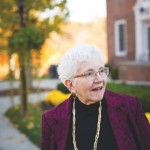
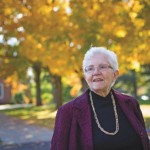
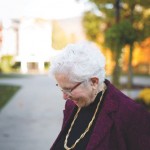
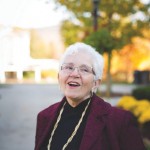
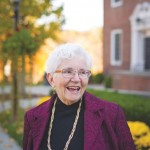
What a pleasure it was to read about my dear friend Karin O’Neil. Karin was a crucial mentor for me as I made the transition from faculty to administration, and her high standards of professionalism, married with consummate good sense and an ever-present sense of humor, made the Academic Office an inspiring and fun place to work. I have now had my own long career at Williston, and I often reflect on what an important mentor Karin was for me.